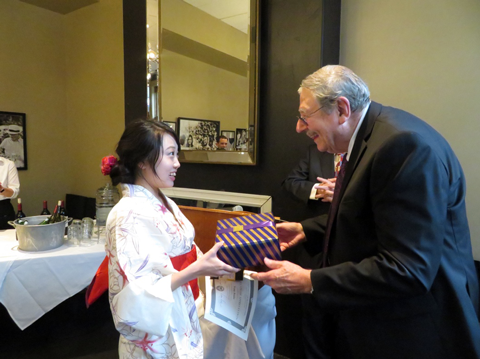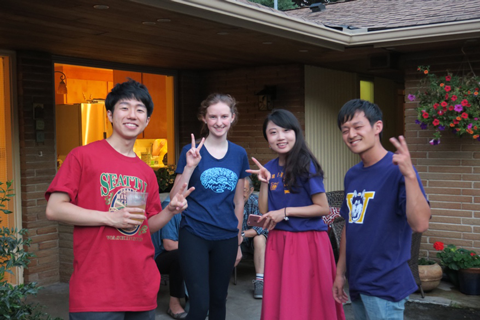国際・国内交流
阿竹 優紗さん(第5学年次)
ワシントン大学での研修を終えて
私はこの度、ワシントン大学における1週間の研修プログラムに参加させていただき、そして、とても1週間とは思えない濃密で有意義な貴重な経験をさせていただきました。
このような機会を用意してくださった、枚方療育園の山西先生を初めとした多くの先生方・職員の方々に感謝しております。私はこの研修を通し、どれほど世界が広く、私の頭の中が狭いかを学びました。世界には何十億人という人々がいますが、すべての人が異なる考え方をしていて、個々に信念があり、決して私と同じではないのだという当たり前のことを改めて目の前に突き付けられました。将来このようなことが原因で問題が発生したとき、ひとつの道しるべとなってくれるのが今回の研修で学んだ生命倫理‟Bioethics”だと思います。その一部をご紹介できればと思います。 まず、この研修で私が最も衝撃を受けたのが、見学させていただいたいくつかの施設、特に小児病院です。その桁違いに大きい規模にも驚かされましたが、何より衝撃的だったことは、「病院臭」が感じられないことです。まるで一等地に存在するオフィスビルの佇まいでとても豪華なのです。向こうの病院は多大なる寄付によって設立されることが珍しくないようですから実現可能なのであって、日本でこのような病院を設立することは難しいのかもしれません。しかし、日本では無駄な設備と一笑に付されてしまうような場所、両親を癒す部屋であったり、とても美しいバルコニー、トレーニングジムや、1階から7階まで繋がる壁の絵、そして触って感じられるデコボコした壁など。病院らしくない設備かもしれませんが、それらはすべて患者さんへの思いやりに溢れていました。例えば両親を癒す部屋には一見贅沢にも思えるマッサージルームやシャワー室がありました。そこで職員の方は、「子供が元気になるためにはまずお母さんが元気でなければなりません。」とおっしゃっていました。このように向こうの病院には患者さんへの思いやりをしっかりと表現していて、大変うらやましく思いました。そしてこの病院ではさらに、白血病を患った少女のお話を通して、小児科の緩和ケアに携わっているHays先生の講義をうけました。その講義の中で10歳ほどの少女が自分の人生において何を一番に重視するかを自分で考え、それに基づいた治療方針を先生や家族と共に決断していました。病状の進行とともに彼女の求めるものが変わっていくのが大変印象的でした。その講義内で利用されていたのが初回の授業でMcCormick先生に教わった「4 box method」でした。次にこのmethodについて紹介したいと思います。このmethodは何か患者さんが問題にぶつかったときに、何を優先すべきか、という患者さん本人の気持ちを整理してくれます。そして医療者側も問題の焦点を患者さんをとりまく背景を含めた広い視点で把握し、さらに経時的にとらえることができるのです。まず初めに、4つの枠を作ります。その中に(1)Medical indications(疾患などの医学的情報、ケアプランなど) (2)Patient preferences(患者さんの情報や本人の意思) (3)Quality of Life(治療方針による生活の質の違いなど) (4)Contextual features(患者さんや病院などを取り巻く背景など) と4つのトピックを掲げ、そこに記入していく、それだけです。疾患と治療だけではなく、重要となる4つのトピックから患者さんにアプローチすることで、その人にとっての最善の治療方針を探っていくことができます。また、第三者から見てもわかりやすい作りになっていますので、患者さんのご家族や、その患者さんに関わる医療職皆が患者さんの状況を把握することができます。そして何度でも書き直せますから、病状の進行具合によって方針の立て直しを何度でも図ることができます。私はこの研修で初めて4 box methodを知りましたが、アメリカではある程度普及しているようでした。そしてこの1週間の中で何度も出てきては、症例に使われたりして、皆とディベートする中でとても身近なものとなりました。はじめに私は、多様な考え方があるということを学んだといいました。どうしても多くの人は自分の考えと全く異なる考え方に出会ったとき、理解の範疇を超えているために、すぐにその考えを受け入れることはできないと思います。昔に比べると日本やアメリカだけでなく、世界的に医療に対する考えが大きく変わり、医者ファーストではなくなりましたが、それでも時に医者は、医学的な知識があるために、患者さんに自分の最良と思う治療を押し付けてしまうことがどうしてもあると思います。そのような倫理問題が発生したときに、この「4 box method」は世界どこでも簡単に使えるツールだと思いました。実習プログラムを通し多くのことを学びましたが、勉強の他にも先生方は多くの経験をさせてくださいました。皆でマーケットやスーパーを回ってショッピングしたり、ディナーの席では引率の先生方のお話を伺って皆で笑いあったり、シアトルという美しく、経済的に発展し洗練された街を観光する機会もいただけました。ディナークルージングは大変豪華でこれもまた一生できないような経験でした。この1週間は振り返ってみると本当に濃密で、一生見ることができないような施設、聴くことができないような講義を体験することができました。私にとって最も大きい収穫は、冒頭にも述べた通り、多様な考え方を知り、視野を広くもつ経験ができたことです。シアトルで出会ったすべての先生、職員の方々がとても親切で優しく、また、同じ医療に従事する者として、惜しみなく私たちに知識を提供してくださり、経験を共有してくださいました。このような貴重な機会を頂けて、感謝してもしきれません。今回の研修に参加させていただけましたのも、枚方療育園の山西先生、引率してくださった蒲生先生、関先生、中野先生、富田先生、金沢さん、梶原さん、ガイドのよしこブラウンさん、いつも私たちを手助けしてくださった通訳のTuridさん。そしてワシントン大学のMcCormick先生、King先生初め素晴らしい講義を毎日してくださった多くの先生方、日本でのアレンジメントをしてくださった国際交流センターの鳥井さん、心より感謝申し上げます。本当にありがとうございました。この研修で吸収したことに無駄はなく、私の未来への糧となると思いますし、一生の思い出となりました。この経験を活かし、胸を張れる医師となります。ありがとうございました。

